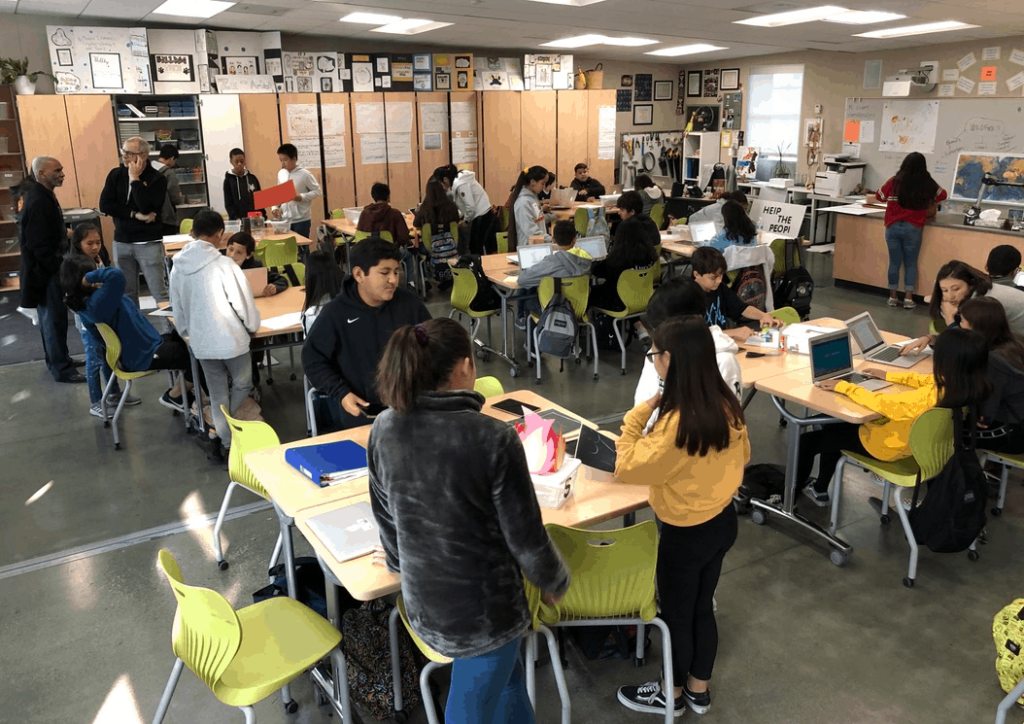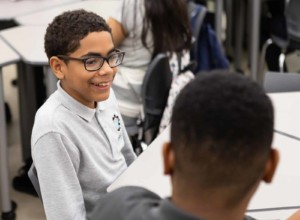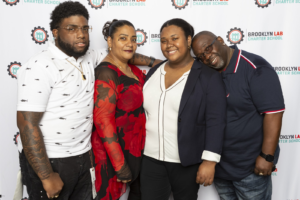We Built Boring Schools, Then We Put Them Online–Science Has the Fix

We created boring schools and then put them online. Our focus on testing made learning small and easy to grade rather than valuable. We pretend there is an average kid who is supposed to be at this thing called grade level. We organize secondary schools in ways that prevent us from understanding learners, building sustained relationships, or doing interesting community-connected work. We don’t focus on or provide any feedback on the most important skills.
Teachers aren’t to blame–it’s the system we inherited. As Tony Wagner has been saying for two decades, “No shame, no blame, no excuses.” Schools are obsolete and must be reinvented.
Ever since the Committee of 10 (old white guys) chopped up the day into uniform courses in 1892, the decentralized political system evolved uninformed by developmental and learning science. But 130 years later, we know enough about learning sciences to get busy. As Wagner said, “No excuses.”
The pandemic laid bare the inequity and inadequacy of the patchwork American system of education. It made clear that learner experience (LX) is an invention opportunity. LX is not just the topics and tasks of the curriculum, it’s the supports, the culture, and how learners interact with their learning environment.
To address the LX opportunity, the Science of Learning and Development Alliance was formed in 2016 bringing together learning science superstars Linda Darling Hammond, Pam Cantor, Karen Pittman, Todd Rose, and David Osher to compile insights and solutions to the persistent inequity and underperformance in our education system.
In the first of a trilogy of papers, SoLD outlined how How Children Learn and Develop in Context. The dense paper put to rest the nature versus nurture debate (it’s collaborative coordination) and outlined the interconnectedness of multiple contexts and the integration of cognitive, social, emotional, and affective processes in development and learning.
The LX opportunity is complicated and multifaceted but 12 strategies stand out:
1. Recognize Individuality: There are multiple pathways to healthy development, learning, academic success, and resilience. Individuals vary in how they learn, behave, and develop. LX design should respect each person’s autonomy and individuality.
2. Anticipate Malleability: Human brains have the remarkable ability to change from experience–it’s the biological opportunity for growth no matter what the developmental beginnings. “None of us can know what a child can become unless we design the environments/context to reveal it,” said Dr. Cantor.
3. Understand Context: Develop a deeper understanding of the whole child in context. Distinguish motivational issues from learning strategy problems and identify their causal factor.
4. Build Relationships: Strong attachments and positive, long-term relationships are key to learning and development. They occur in safe learning communities where students feel they belong and are known.
5. Set Priorities: Focus on foundational skills and belonging, self-efficacy, and a growth mindset.
6. Build on Prior Learning: Students are not “blank slates”—they are active agents who bring to school prior knowledge and experiences. Learning starts by meeting students where they are.
7. Engaging Tasks: Learning should foster active student engagement. Well-designed, interdisciplinary projects can balance what students already know with what they need and want to know. They can combat the pedagogy of poverty and support rigorous academic work.
8. Quality Feedback: instructional design should seek to provide the right amount of challenge, rigor, support, feedback, and formative assessment to drive and accelerate the developmental range and performance of individual students. Self-regulation and academic growth is developed with quality feedback.
9. Risk Factors: All children are vulnerable. Adversity, through the biological process of stress, exerts profound effects on development, behavior, learning, and health. Adult buffering of risk factors and assets from relationships and a sense of belonging foster resilience and accelerates healthy development and learning.
10. Explore Motivation: A complex mix of beliefs, values, interests, goals, drives, needs, reinforcements, and identities influences choices, persistence, and effort. The perceived utility of a task and the intrinsic and extrinsic motivations are unique for each learner.
11. Metacognition: Becoming aware of one’s own thinking and learning depends on foundational self-regulation and executive function skills. Metacognition skills help learners evaluate their own learning and engage in self-direction.
12. Unique Pathways: There are no ideal developmental pathways. There are multiple pathways to healthy development, learning, academic success, and resilience. A “constructive web” of supports can engage learners as an active agent in his/her own learning to set scaffolding, sequencing, and pacing.
If that all sounds complicated, it is–learning and development are highly individual. These 12 factors suggest supportive learning environments and sustained relationships. The opportunity is not about working harder, it’s creating smarter systems. The last three factors suggest that learners can and should take on an increasingly active role in co-constructing learning pathways themselves as well as providing peer support and mentoring younger learners.
Better Tasks and Tools
Four examples of well-developed LX systems supported by innovative tools include:
- The 200 New Tech Network schools support team-taught integrated projects with authoring tools and a library of tasks that can be adopted or adapted.
- Purdue Polytechnic High in Indianapolis combines individual skill sprints with community-connected projects.
- One Stone in Boise combines purposeful explorations, with design labs, and community-connected projects.
- The 200 global Acton Academy affiliates create environments where learners become self-directed aided by peer support and mentoring.
Each of these systems, as SoLD suggests, combines affective, cognitive, social, and emotional processes with curricular content to promote academic growth. Each of the extended challenges seeks “the right amount of challenge, rigor, support, feedback, and formative assessment to drive and accelerate the developmental range and performance of individual students.”
The Learner Variability Navigator system from Digital Promise helps curriculum designers and edtech vendors design tasks and tools to reach each learner. It’s a whole-child research framework for practitioners and edtech product developers. Vendors can earn certification as a research-based product.
The LX opportunity is as big as a whole new learning system and as small and focused as a project next week crafted with purpose and connected to place.
For more, see:
Stay in-the-know with innovations in learning by signing up for the weekly Smart Update.
To help inform and deliver new agreements, new practices and new tools Getting Smart and eduInnovation are exploring the Invention Opportunity thanks to support from the Walton Family Foundation and the Bill & Melinda Gates Foundation. The findings and conclusions contained within are those of the authors and do not necessarily reflect positions or policies of the foundations.








Stephen Downes
I've taken this article as a frame for my own discussion of '12 Degrees of Freedom', responding point by point to the 12 items.
https://halfanhour.blogspot.com/2020/11/12-degrees-of-freedom.html
The freedom to decide who I am
The freedom to define how I am seen
The freedom to decide what interests me
The freedom to choose who I associate with
The freedom to decide what matters most
The freedom to decide what counts as success
The freedom to do what I want to do
The freedom to decide what is right
The freedom to decide what risks are worth taking
The freedom to decide what I need
The freedom to learn my own way
The freedom to create my own map of the world